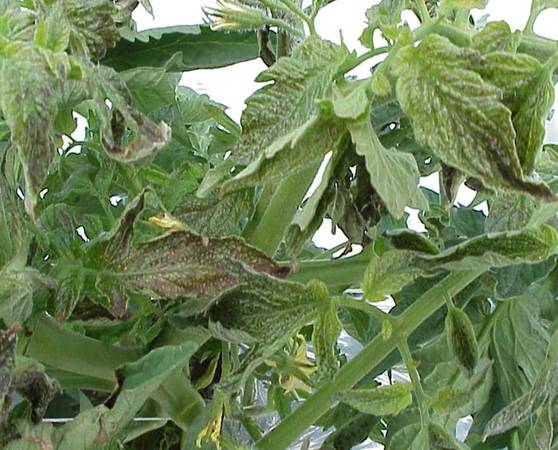
by Eddie Powell | Jun 3, 2014
During this growing season monitor your plants and keep them healthy as a healthy plant will be able to better survive an invader attack.
Nematode populations can be reduced temporarily by soil solarization. It is a technique that uses the sun’s heat to kill the soil-borne pests. Adding organic matter to the soil will help reduce nematode populations as well. Nematodes are microscopic worms that attack vegetable roots and reduce growth and yield. The organic matter will also improve water holding capacity and increase nutrient content.
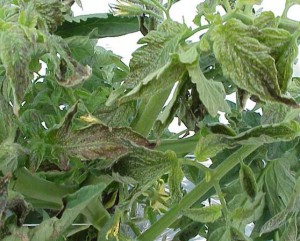
Tomato Spotted Wilt Virus
Credits: UF/IFAS
If you choose to use pesticides, please follow pesticide label directions carefully. Learn to properly identify garden pests and use chemicals only when a serious pest problem exists. If you have questions please call your UF/IFAS county extension office. We can provide helpful information about insect identification.
Organic gardeners can use certain products like BT(Dipel) to control pests. Please remember not every off-the-shelf pesticide can be used on every crop. So be sure the vegetable you want to treat is on the label before purchasing the product.
Follow label directions for measuring, mixing and pay attention to any pre-harvest interval warning. That is the time that must elapse between application of the pesticide and harvest. For example, broccoli sprayed with carbaryl (Sevin) should not be harvested for two weeks.
Spray the plant thoroughly, covering both the upper and lower leaf surfaces. Do not apply pesticides on windy days. Follow all safety precautions on the label, keep others and pets out of the area until sprays have dried. Apply insecticides late in the afternoon or in the early evening when bees and other pollinators are less active. Products like malathion, carbaryl and pyrethroids are especially harmful to bees.
To reduce spray burn, make sure the plants are not under moisture stress. Water if necessary and let leaves dry before spraying. Avoid using soaps and oils when the weather is very hot, because this can cause leaf burn.
Control slugs with products containing iron phosphate.
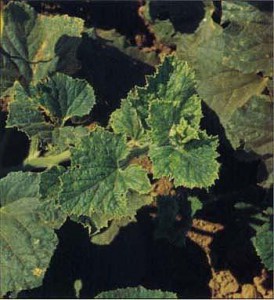
Cucumber Mosaic Virus
Credits: UF/IFAS
Many common diseases can be controlled with sprays like chlorothalonil, maneb, or mancozeb fungicide. Powdery mildews can be controlled with triadimefon, myclobutanil, sulfur, or horticultural oils. Rust can be controlled with sulfur, propiconazole, ortebuconazole. Sprays are generally more effective than dusts.

by Taylor Vandiver | Jun 3, 2014
In a world of limited time and space, container gardens seem to make more and more sense. Poor soil and no place to put plants in the ground are no longer good excuses for not being able to enjoy the simple pleasures of gardening. Container gardening allows the individual to create gardens to fit any situation. Gardening in containers can be just as rewarding as having a full-size garden.
There are a few items to consider when you are planning your container garden. The first is the plants you intend to use. If you are planting more than one plant in the same pot be sure that all your plants meet the same requirements. The requirements you should consider are amount of light, amount of water, climate and fertilizing needs. Some other things you might want to think about when planning your container garden are height, color, and texture. A nice variation of these elements will make your container gardens more attractive and increasingly more interesting to look at.
The next step in container gardening is choosing your container. A good rule of thumb is: “Anything that holds soil and has drainage holes in the bottom may be transformed into a container garden.” It can be a pot you purchased from the local gardening center or an old bathtub you picked up off the side of the road. However, be sure that the size of the container matches the current and potential size of your plant. For vibrant plant growth, the containers must provide adequate space for roots and soil media, allowing the plant to thrive.
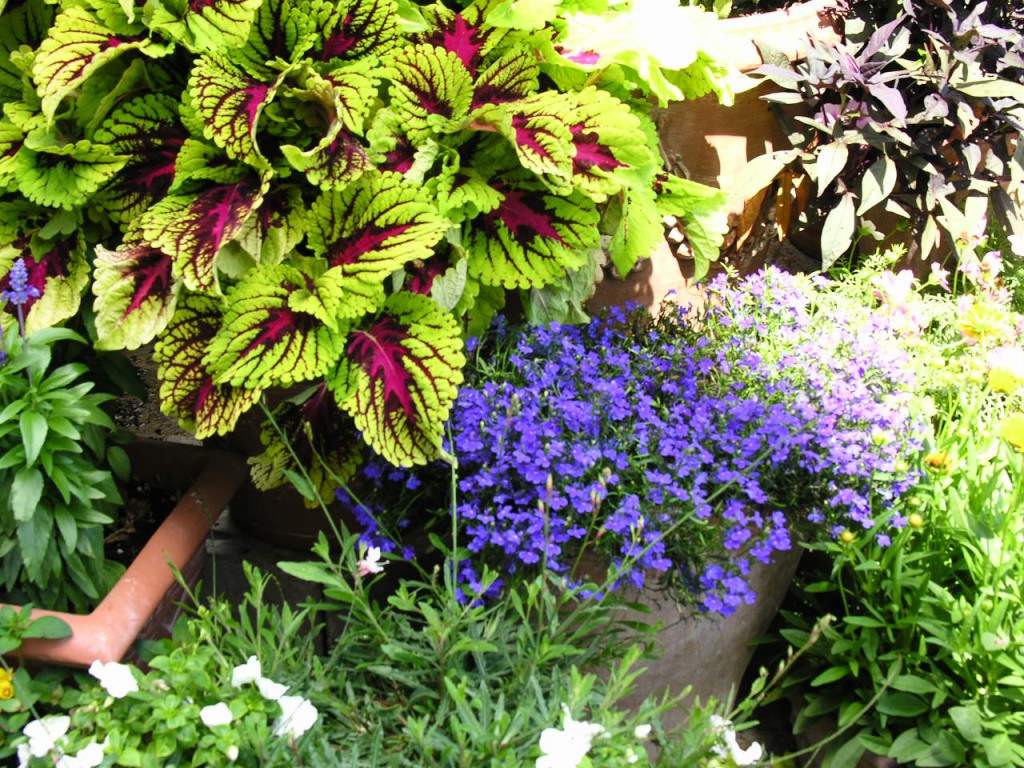
Colorful containers bring life to your small spaces.
Next on your list is choosing a soil for your container. Container soils need have good aeration and decent drainage, while still being able to retain enough moisture and nutrients for plant growth. When choosing what to use in containers, never use garden soil by itself. When garden soil is added to a container, both drainage and aeration are severely impeded, and the results are plants that grow poorly or not at all.
Container soils are often referred to as soilless or artificial media, because they literally contain no soil. They are commonly composed of various media such as peat moss, perlite, vermiculite, bark and coir fiber (ground coconut hulls) in a variety of mixes. When using soilless media remember t0 moisten it slightly before planting. Fill a tub with the media, add water and lightly fluff the media to dampen it. This will keep the mixture from becoming hydrophobic (unable to take up water) throughout its life in the container. When adding media to your containers, never fill the pot to the top. You should leave about a one-inch space between the top of the soil and rim of the pot. This will make watering the pot easier as it provides a place to “put water” and not have it run over the edge.
When watering your container gardens, the best time to do so is in the morning. Watering in the morning allows the leaves of your plants and soil to dry out, preventing diseases and viruses. Remember that overwatering is the most common reason for fatalities in container gardens. Check your soil by pushing your finger into the media; if the media is moist don’t water it. When it comes to fertilizing your container gardens, fertilize only as needed. Over-fertilization will result in a buildup of salts and may burn the roots of your plants. Try to fertilize your plants during the growing season, and only if needed during the dormant seasons.
The most important objective when container gardening is to be creative. Maybe, try a variety of plants in one container garden. While an nicely put together individual container can be quite impressive, think what might happen if you put several containers together in a group. Also, don’t limit your container gardens to flowers–many vegetables can be grown in a container and actually do quite well. There really is no limit to what can be done in a container!
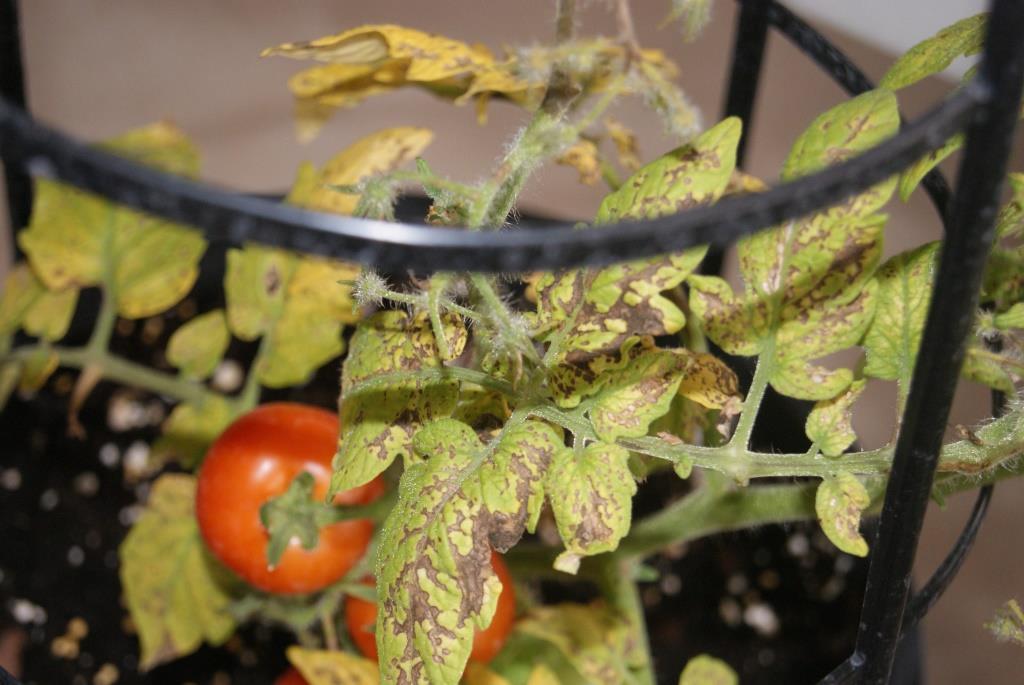
by Matthew Orwat | May 20, 2014
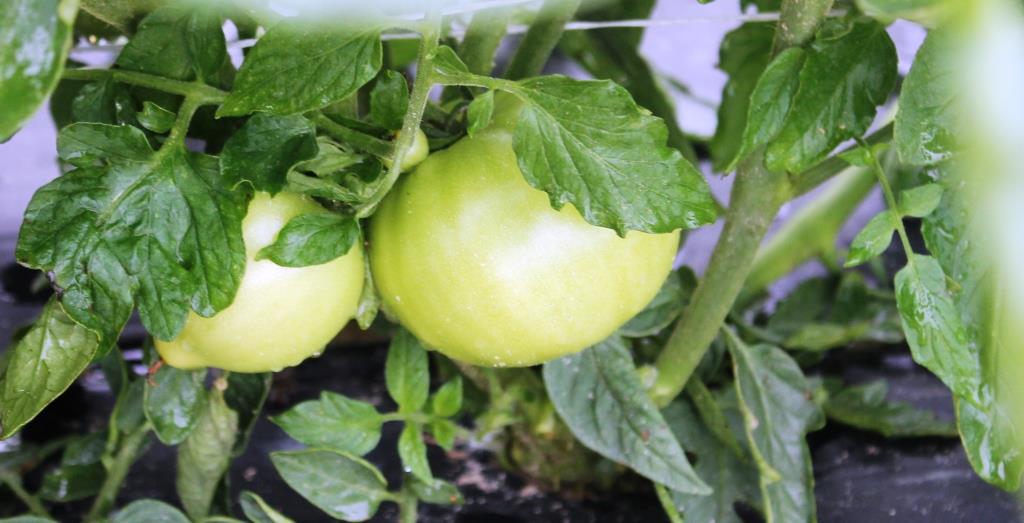
Healthy, Developing Tomato. Image Credit Matthew Orwat
One of the most common tomato problem home gardeners encounter in the late spring and early summer is blossom end rot. The good news is that blossom end rot can be prevented with the use of drip irrigation and adequate fertilization. Since tomatoes need a consistent supply of water to prevent blossom end rot, drip under plastic works well. Blossom end rot effects crops in the solanaceae family and appears as a grey, mushy dead area at the base of the vegetable. It is caused by calcium deficiency but is usually a result of wet / dry cycles brought on by an inconsistent irrigation program. The best cure for blossom end rot (BER) is a consistent level of soil moisture throughout the fruiting cycle.

Bacterial Leaf Spot Symptoms
Due to recent rain, warm days, and cool nights, leaf diseases could be developing, so now is a good time to scout tomatoes.Look for brown spots, spots with halos, wilting leaves, and yellowing leaves. This could be a sign of bacterial leaf spot, which is transmitted when rain splashes soil and water on leaves of the plants. Affected leaves should be removed from the growing area and destroyed. Once leaves are affected, there is no cure, but preventative sprays of copper-containing fungicide (bactericide) plus mancozeb sprays can reduce incidence of infection, if the spray program is initiated before too many spots are present.
For a detailed look at the various diseases of tomato, the EDIS publication “A Series on Diseases in the Florida Vegetable Garden: TOMATO” offers an excellent summary. Another resource UF/IFAS offers for disease diagnosis is the NFREC U-scout website. U-Scout provides information on over 40 potential disease issues in tomato. Additionally, any plant disease can be diagnosed through your County Extension Office and the Plant Pathology lab at the North Florida Research and Education Center.
by Eddie Powell | Apr 29, 2014

Five Gallon Container Plants
Credit: Eddie Powell

One Gallon Container Plants
Credit: Eddie
GARDENING IN A BUCKET: Grow wholesome, healthy vegetables in a container with this plan.
Materials
-
5 Gallon plastic buckets
-
40 pound sacks of Potting soil
-
40 pound sacks of compost
-
garden trowels or shovels
-
wheel barrow or other large mixing container
-
controlled release fertilizer
-
packs of vegetable seeds
Recommended: All Herbs, Tomato, Cucumber, Squash, and Zucchini
Procedures:
-
In a large container or on a plastic mat on the ground, mix potting soil and compost in a 2:1 ratio. Two scoops of soil and one of compost, add ½ cup time release fertilizer, every 6 weeks
-
Drill 6 to 8- ½ inch holes in the bottom of the 5-gallon buckets. Make sure that the buckets did not contain toxic materials!
-
Fill the bucket to within 3 inches of the top of the container
-
Place container in sunny spot that will allow drainage
-
Plant chosen vegetable with two seeds in center of the container
-
Water well and keep moist but not wet
Plant requirements:
-
Minerals. Basic needs in plants are Nitrogen (N), Phosphorus (P), Potassium (K). These are listed on all fertilizers as a ratio, example – 8-8-8 contains 8 % Nitrogen, 8% Phosphorus, and 8% Potassium 76% being filler.
-
Sunshine or artificial sources of light (grow lights).
-
Water. Soil must be kept moist but not wet. Wet soils will create root-rot and encourage fungus. Measure moisture by pinching the soil to determine if the soil is moist. Adding water as needed; plants in full sun will need much more water than plants in partial shade. Wilted plants need more water!
-
Carbon Dioxide (CO2). Plants absorb CO2 and give off Oxygen making them VERY important to human and all animal life.
-
Proper Temperatures. Too cold, plants die, too hot plants die. Make sure that if your plants are outside and the temperature goes below freezing, the plants are protected.
by Roy Carter | Apr 21, 2014

Corn Field. Image Credit Matthew Orwat
Sweet corn is a favorite among home gardeners. As long as the space is available, it’s not difficult to grow.
Corn is a new world native crop, with archaeological evidence suggesting that it was first domesticated in Mexico. This crop was the basis of the Mayan, Incan and Aztec civilizations, and by the time European explorers came to the New World in the 1500s, corn had become a staple for the native people.
Corn is monoecious (mon-ee-shuss) which means that there are both male and female flowers on each corn plant. In some monoecious plants, male and female parts are in the same flower. In corn, male and female flowers are in different locations, the male flowers form a tassel which is at the top of the plant. The female flower is located at the junction of leaves and stem. It consists of collection of hairs (silks) enclosed in the husks of what will become the ears. There silks are pollen receiving tubes. Wind-blown pollen from the mole flower (tassel) falls on the silks below. Each silk leads to a kernel, and pollen must land on all silk for the ear to fill out completely with kernel.
Corn comes in a variety of colors and sugar contents. Look for sugary enhanced varieties, with firm and sweet kernels, or the super sweet varieties, with tender and very sweet kernels. Some varieties of white and yellow corn that perform well in Florida are Silver Queen (white), “How Sweet It Is” (white), “Sweet Ice” (white), “Merit” (yellow), “Kandy Korn” (yellow), and “Peaches and Cream” (bicolor).
Sweet corn thrives best in well-drained soils but will tolerate a wide range of soil types. Optimum pH ranges from 6.0 to 6.5.
Till the soil to a depth of 6 to 8 inches using a spade, plow or rototiller. Avoid tilling the soil while it is too wet because clodding may occur.
Sweet corn is a warm-season vegetable requiring soil temperature between 60-90 degrees F°. Avoid planting seed in cool soils. Wait until after the last average dates of the last killing frost before planting. If planted too early, weak stands, stunted growth or frost-killed seedling may result. The newer, sweeter varieties are even more sensitive to cool, wet soils any may not perform well in these conditions.
Plant corn in an area that receives at least 6 to 8 hours of sunlight. It is beneficial to plant near a water source for needed irrigation.
Plant seed approximately 1 to 1 ½ inch deep in rows 3 feet apart with 8 to 12 inches between each seed in the row. A hand pushed mechanical planter can make seeding much easier for larger stands of corn.
A soil test through the local County Extension Office is always the best way to determine the lime and fertilizer needs. If lime is required, it can be tilled into the ground during soil preparation but is most effective when applied 2 to 3 months prior to planting.
If a soil test is not done, a general guideline is to apply 3-4 pounds of 10-10-10 per 100 linear row feet before planting. Side dress two or three times during the growing season with ammonium sulfate (21-0-0-17) at the rate of 2 pounds per 100 feet of row space. More frequent side dressing may be required on sandy soils or when excessive ran occurs.
Corn requires a minimum of 1 inch of water per week for normal development. The most critical period for water is during pollination and during final ear filling.
Sweet corn matures in 60 to 100 day, depending on the varieties. Sweet corn should be ready for harvest about 20 days after the appearance of the first silk stands, sweet corn is picked during the “milk stage” when the kernels are fully formed but not completely mature.
After picking, cook and eat corn that day or store it in cool temperatures, such as in a refrigerator, as soon as possible. It can then be canned, frozen or eaten fresh within few days. Keeping the corn cool is the key to better flavor as high temperatures will convert the sugar in the kernels to starch, giving it a bland taste.
by Blake Thaxton | Apr 8, 2014

Currently, there is an heirloom tomato variety trial being conducted in a high tunnel  structure at the UF/IFAS West Florida Research and Education Center. Seven heirloom tomato varieties are being evaluated, along with one hybrid variety, for early season high tunnel production in the western panhandle of Florida. Now is a chance for vegetable producers and tomato garden enthusiasts to see the trial and get the most up to date production advice from UF/IFAS specialists and extension agents. Join us for the workshop, Tomatoes at Twilight!
structure at the UF/IFAS West Florida Research and Education Center. Seven heirloom tomato varieties are being evaluated, along with one hybrid variety, for early season high tunnel production in the western panhandle of Florida. Now is a chance for vegetable producers and tomato garden enthusiasts to see the trial and get the most up to date production advice from UF/IFAS specialists and extension agents. Join us for the workshop, Tomatoes at Twilight!
Topics to be discussed:
• General Tomato Production
• High Tunnel Tomato production
• Heirloom Tomatoes
• Water & Nutrient Management
• Disease Control

















